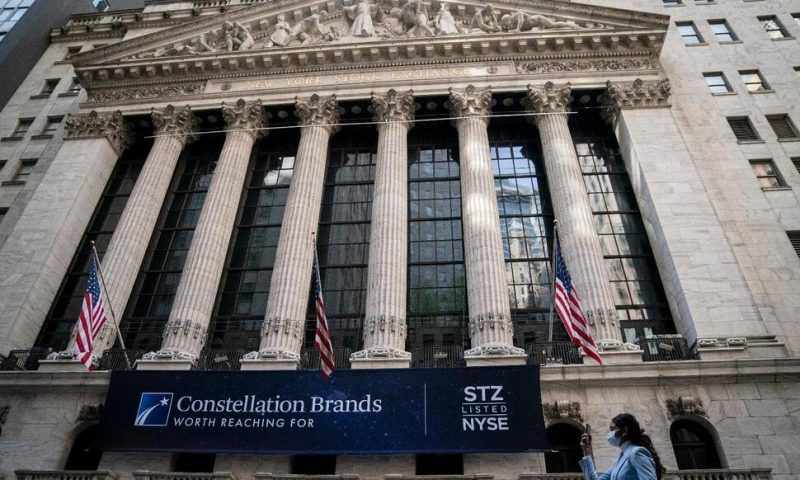Stocks closed lower on Wall Street ahead of a key decision on interest rates by the Federal Reserve.
Stocks finished broadly lower Tuesday as Wall Street, increasingly anxious about the slowing economy, looks ahead to a widely expected interest rate hike by the Federal Reserve in its bid to squash the highest inflation in decades.
The S&P 500 index fell 1.1%, as more than 90% of stocks and every sector in the benchmark index lost ground. The Dow Jones Industrial Average and Nasdaq composite also fell 1%.
The selling came as traders waited to see how high the Fed will raise interest rates at its meeting that ends Wednesday. The central bank is widely expected to announce a hefty three-quarters of a point interest rate increase, its third such hike in a row. Investors also will be listening intently to Fed Chair Jerome Powell for any clues on how aggressively the Fed will move from here to tame inflation.
“The market is certainly bracing for the worst and you’re seeing a little bit of selling pressure coming in,” said Paul Kim, CEO of Simplify ETFs.
The S&P 500 fell 43.96 points to 3,855.93, while the Dow dropped 313.45 points to 30,706.23. The Nasdaq lost 109.97 points to close at 11,425.05.
Retailers, technology stocks, health care companies and banks were among the biggest weights on the market. Best Buy fell 4.1%, Microsoft slid 0.8%, Abbott Laboratories dropped 1.7% and JPMorgan Chase closed 2% lower.
U.S. crude oil prices fell 1.5% and weighed down energy stocks. Exxon Mobil fell 0.8%.
Smaller company stocks fell more than the broader market. The Russell 2000 index gave up 25.34 points, or 1.4%, to 1,787.50.
Bond yields mostly edged higher. The yield on the 10-year Treasury, which influences mortgage rates, rose to 3.56% from 3.52% from late Monday and is trading at its highest levels since 2011.
The yield on the 2-year Treasury, which tends to follow expectations for Fed action, held steady at 3.95%, hovering around its highest levels since 2007.
Stocks have been slumping and Treasury yields rising as the Fed raises the cost of borrowing money in hopes of slowing down the hottest inflation in four decades. The central bank’s aggressive rate hikes have been making markets jittery, especially as Fed officials assert their determination to keep raising rates until they are sure inflation is coming under control.
Powell bluntly warned in a speech last month that the rate hikes would “bring some pain.”
“He has done everything he possibly can to signal that it’s going to be another aggressive move,” said Liz Young, head of investment strategy at SoFi. “He’s been clear as a bell about what they’ve been focused on.”
The Fed is expected to raise its key short-term rate by a substantial three-quarters of a point for the third time at its meeting on Wednesday. That would lift its benchmark rate, which affects many consumer and business loans, to a range of 3% to 3.25%, the highest level in 14 years, and up from zero at the start of the year.
If the Fed matches expectations for a three-quarters of a point increase, that may give stocks a small boost, reflecting relief among traders that the central bank didn’t opt for a 1% increase, said Kim.
Beyond that, investors will be focused on what Powell has to say, both in the Fed’s latest interest rate policy statement and during an afternoon press conference, for clues as to whether the central bank remains primarily focused on lowering inflation, or if there’s a hint the Fed is giving more consideration to the impact of higher rates on the economy.
“As long as the Fed sticks to this game of chicken and sticks to inflation as its only mandate, the market will keep dropping,” Kim said.
Wall Street is worried that the rate hikes could go too far in slowing economic growth and push the economy into a recession. Those concerns have been heightened by data showing that the U.S. economy is already slowing and by companies warning about the impact of inflation and supply chain problems to their operations.
Ford fell 12.3% for the biggest decline in the S&P 500 after slashing its third-quarter earnings forecast because a parts shortage will leave it with as many as 45,000 vehicles unfinished on its lots when the quarter ends Sept. 30. Last week, FedEx and General Electric warned investors about damage to their operations from inflation.
The U.S. isn’t alone in suffering from hot inflation or dealing with the impact of efforts to fight high prices.
Sweden’s central bank on Tuesday raised its key interest rate by a full percentage point to 1.75%, catching almost everyone off guard as it scrambles to bring down inflation that was measured at 9% in August.
Consumer inflation in Japan jumped in August to 3%, its highest level since November 1991 but well below the 8% plus readings in the U.S. and Europe. The Bank of Japan is set to have a two-day monetary policy meeting later this week, although analysts expect the central bank to stick to its easy monetary policy.
Rate decisions from Norway, Switzerland and the Bank of England are next.
Markets in Europe mostly fell, while markets in Asia gained ground.

